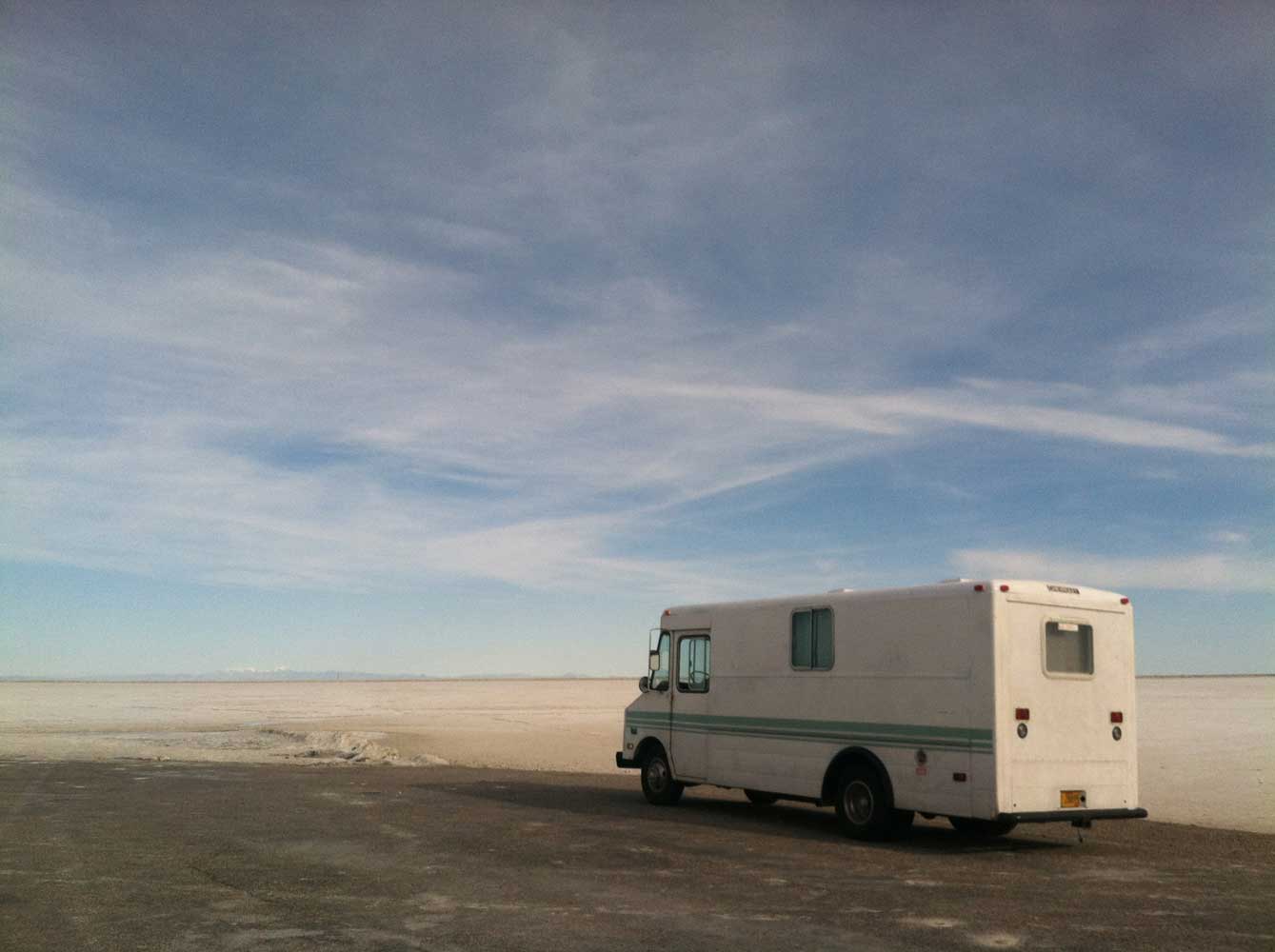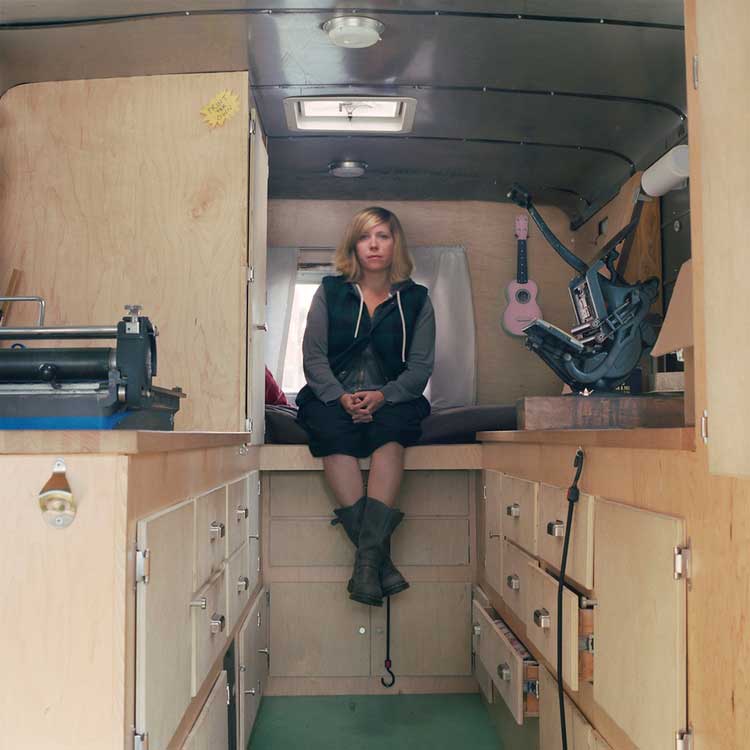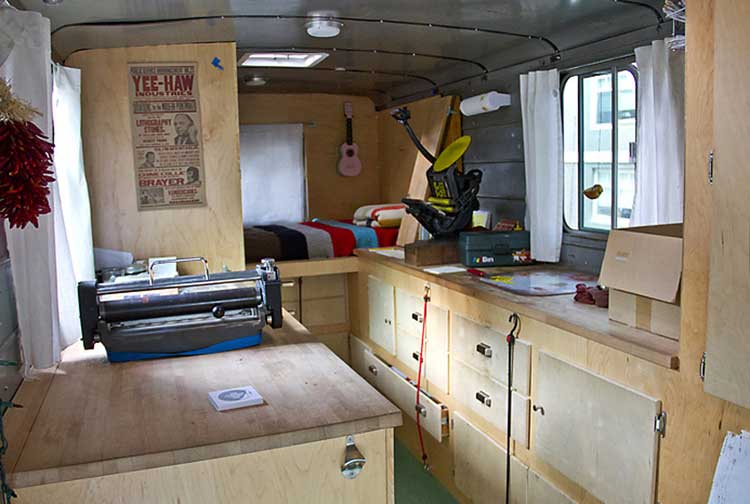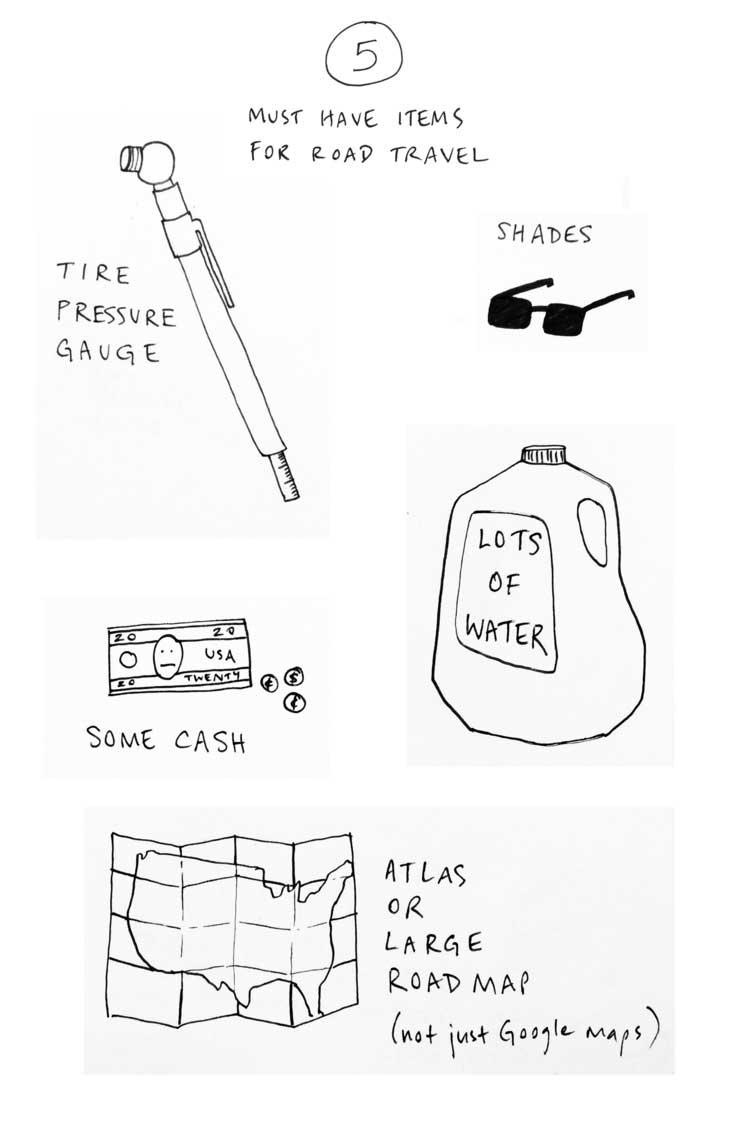Kyle Durrie of Power & Light Press

Type Truck
Kyle’s is a unique story. She is a letterpress printer who traveled around the United States from 2011 – 2013 in a 1982 Chevy Step Van that she converted into a mobile letterpress studio. Along the way, she printed, taught others how to print, and experienced life on the road. She learned that life and art is messy, and that’s how she likes it best.
Learn more in the interview below.
Photos above and below (C) 2015 Kyle Durrie
Meet Creative, Independent Kyle
How did your trip come to be?
Back in 2010, I was in creative rut. I had been working for myself, running my letterpress print shop, Power and Light Press, for about a year and a half. I was a pretty good printer, and I knew how to crack jokes and print funny cards and package them up all nice in the hopes that someone would buy them. But no one was really buying, not enough to make a living, anyhow. And so I pursued custom work, mostly wedding invitations, to make ends meet. I was figuring it out, paying the bills, doing what I needed to stay afloat. I was learning a lot about design and deadlines and client relations and expectations. I was learning more than I ever thought I’d learn about the wedding industry. And I was printing every single day, putting in 12, 13, 14-hour days at the studio, 7 days a week. And while I was grateful to be able to print as my job, I came to realize that I didn’t really love the actual work. In the frenzy of starting my own business and having to support myself, I had very quickly lost sight of who I am as an artist, what I’m good at, and why I love this work. And what’s the point of being self-employed if you don’t love what you do? It’s not like you’re being paid handsomely.

Photo (C) 2015 Kyle Durrie
And so, in September of 2010, I decided to take a much-needed vacation and tag along with my boyfriend’s band on a three-week cross-country tour. I’ve always found road trips inspiring – getting out and seeing new places, changing your pace and perspective. I always come home feeling reinvigorated and balanced. In that sense, this trip was no different, except that touring with the band unlocked something new, and this trip turned out to be the launching point for what would become a completely new life path for me. I loved just sitting back and watching them do their thing. I’d taken plenty of road trips before, but this was such a different process, so much more social and dynamic. The music was what gave us direction – it was a means of communicating with people, of making connections, forging relationships, and exploring new places. Playing shows and meeting other musicians and listeners allowed us to discover and engage with a very “real” side of every town we stopped in, an experience you don’t get when you’re just stopping for lunch before getting back on the highway.
I felt envious of these guys, but just for a second. Then I felt inspired. By the time we got back home, the plan for Moveable Type had been hatched.
Why the 1982 Chevy Step Van? How much work did it take to convert it into a mobile studio?
Letterpress has never really been considered a “portable” endeavor… The equipment is big and heavy, antiques made from cast iron and lead. But I just needed to get creative and figure out how to scale everything down. I had watched the band load and unload guitars, amps, a drum kit, and an upright bass from a minivan night after night… if those guys could manage that, I could figure out a way to bring my smaller printing gear on the road. But I knew I didn’t want to just cram everything into a vehicle, mixed in with dirty laundry and bottles of tequila. I wanted an organized, functional print studio that I could teach in and make my own work. I also wanted to live in it while I was on the road (and have a designated space for my dirty laundry and bottles of tequila).

Photo (C) 2015 Tanja Hollander
I decided the most practical option would be a step van (like a food truck). Its boxy shape makes it easy to build out, the payload seemed about right for carrying heavy equipment, and the price was right. I scoured craigslist looking at trucks, and ultimately found The One – a 1982 Chevy Step Van. In its previous life, it had been a linen delivery truck, and the ghost of its original signage can still be seen on the outside wall in the right light.
It took a lot of work to do the conversion, but I was able to condense it into a fairly short amount of time – about two months for the whole conversion. I had run a successful Kickstarter campaign in late 2010, and had raised enough money to buy the truck, make the necessary mechanical repairs, and build out the interior. I designed the cabinetry and layout, and handled the demolition of the existing interior and then re-insulated the walls and ceiling. But then I hired a carpenter and a welder to build cabinetry that would be structurally sound enough to carry heavy things along many, many miles of road.
The design was simple and functional – a galley style layout, with two long counter tops / work spaces with storage underneath, and a sleeping bunk in the back, with more storage below. I used unfinished pine for the cabinetry, butcher blocks counter tops, and I left the original raw sheet metal walls exposed throughout, except for in the bunk, where I wanted something a little cozier (warm maple paneling). I had a cooler and a camp stove, but no other facilities on board.
You mention on your site that you love Americana and road trips. How did your two years on the road shape your letterpress work?
More than anything, the time on the road changed my fundamental approach and attitude toward my work, more so than my subject matter.
The prints I made in the truck are not my finest work. They were often sloppy, off-center, smudgy, simplistic. Much of the design work was really lazy. Some of the jokes were really lame. Some days I was just really, really tired. But the work I’ve made in that truck represents a renewal of vows, so to speak – getting back to basics and remembering why I fell in love with printing in the first place: it’s a really fun way to make stuff.

Photo (C) 2015 Kyle Durrie
If there’s one thing printing in a truck can teach you, it’s to loosen the hell up. Sure, I had a pica stick (a printer’s ruler) and some teeny tiny beautiful type on hand, and my little press is actually capable of printing quite well. But that press also constantly rattled out of alignment as I drove down our country’s oft-wrecked highways, I had no climate control in that metal box – inks were a melty mess in July, and rock solid in January. Sometimes I’d be parked on a fairly major incline. Sometimes there would be beer involved. When your conditions are such, who really cares about a perfect print? That’s not really the point.
You traveled the country, creating and teaching others. How did people react to the tangible product you were able to provide? Were people surprised by the craft?
For the most part, people seemed SO PSYCHED to have an excuse to make something with their hands. I worked with all kinds of people – elementary school kids, college football players, writers, graphic designers, cowboys, random people on the street – but what they all had in common was a shared moment of “ah!” as they lifted their paper off the press to see what they had made. That was something that never got old. We spend so much of our lives in front of our computers or phones these days, busily doing stuff, but not actually making anything tangible. I really wanted to offer an experience to people to just use their hands and make something – didn’t matter if it was good or bad. I tried to be a good teacher, to talk about the history of letterpress printing, and show examples of “fine” printing so they could see just how far it’s possible to take things. But I also tried to teach them that they shouldn’t feel beholden to this level of perfection, that they shouldn’t be afraid to just get in there, get their hands dirty, and make something. It’s what makes us human.
Do you have any tips for women traveling solo?
Just do it. Seriously. Be safe and be aware of yourself and your surroundings but, otherwise, there is really nothing to be afraid of. You will meet some weirdos out there, and you will draw some unwanted attention, but you will also meet some of the loveliest, most inspiring people along the way. My experience has been a little unusual, in that I have these extremely social moments where I’m teaching workshops or talking to large groups of people, but then those times are punctuated by long stretches of solitude – sometimes days at a time on my own, not interacting with anyone else. I love those times the most. When you travel alone, you will be very alone. Get into it. Because it is in those times that you will learn so, so much about yourself and what you are capable of.

Take a photo (or any other means of expression) of your 5 must-have items for road travel.
Sketches to the right ——>
Can you recall your most uplifting moment on the road?
Waking up in some of the most spectacularly beautiful places in this country – that never got old.
Also, meeting a kind-hearted mechanic in south Florida who took a shine to me and my story, and didn’t charge me for the (substantial) repairs he had just done on the truck. He said I reminded him of his daughter and sent me off with new brakes and said, “You stay safe out there, kiddo”. I will never forget him. I have experienced tremendous generosity on the road, from people who have opened their homes to me, bought me a meal, or just shared a nip from their flask around a campfire.
On the flip side, what was your lowest moment?
Getting sick on the road is the worst. I spent three days convalescing in eastern Nebraska before getting back on the road, still slightly feverish, to make up some lost time. Look at a map of Nebraska, and locate the emptiest spot. That is where my truck broke down. Five hours later and one verrrrry expensive tow to the nearest service station, I learned that nothing was wrong with the truck, I had just run out of gas. My gas gauge has been broken since I bought the truck, but still. Frustrating, expensive, and humbling.
How did you know it was time to slow down and stay in one place for a while (New Mexico)?
I just got really, really tired. And I also wanted to spread out and really get back to work. Of course, I was able to print and make things in the truck, but I was feeling ready to get back into a different kind of creative space and see what I could do with all the ideas and sketches I had been gathering along the road. My boyfriend and I had been traveling separately all year, and every time we talked, we’d dream about New Mexico. It’s always been a very special place for us, and we knew that’s where we wanted to put down some roots. We met back up in Portland, hung out there for a few months, and then made tracks south to Silver City, New Mexico. We’ve been here for two years now, with lots of time still out on the road, both together and independently. It’s definitely our home base, but we still think of it as just that – a place to wander away from, and a place to come back home to.
Any plans to hit the road again? Will it involve the Type Truck if so?
Whether in the Type Truck or not, traveling is still a huge part of my life – I’m actually writing this from an artists residency in North Carolina right now [January 17, 2015]. It’s really important to me to step away from my normal work life and surroundings and gain a different perspective. It informs my creative process in a new way, as well as my own process of just being a person. No current plans to take the Type Truck back out on the road, but we’ll see. It is currently enjoying an extended staycation in my yard, and functions as a guest room for traveler friends. It feels great to finally be able to repay the favor and offer a comfy bed, warm meal, and glass of whiskey to those passing through.
Be the first to comment